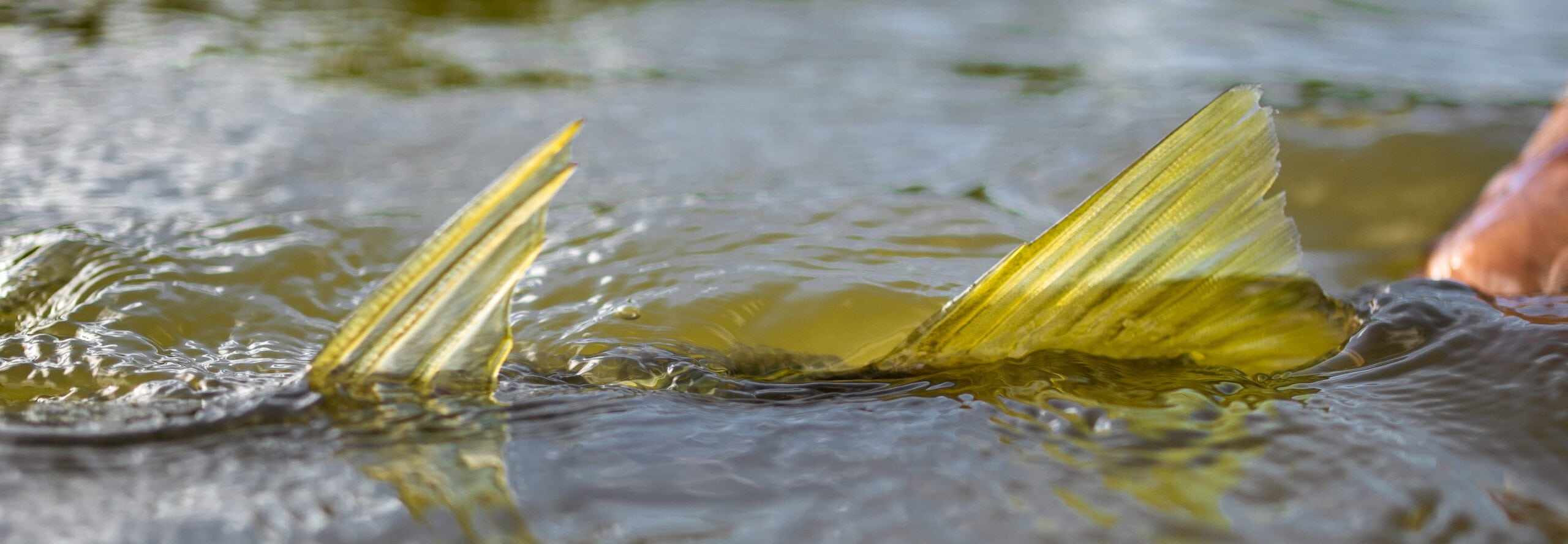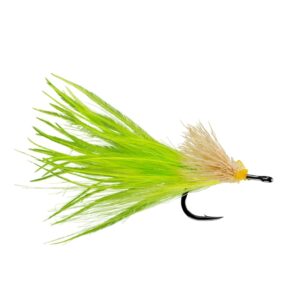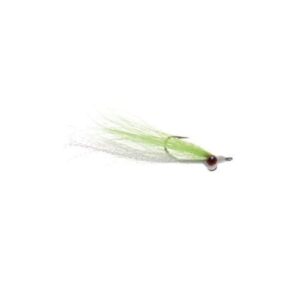
When it comes to catching large snook, there are a few flies that stand out. This list of the top 10 snook flies will give you some insight into how, when, and where to fish them for the best success. Snook are predatory fish that are normally eager to eat a fleeing baitfish. An important aspect of snook fishing is making the fly look like it is fleeing to produce the reactionary strikes. Although it sometimes takes a little more finesse to entice them to eat, remember that their predatory instincts will kick in while fishing for them. With that being said, let’s jump into the flies.
1. Tuscan Bunny
Ah yes, one of my personal go-to snook fly patterns. I love this pattern in both the black/purple and chartreuse colors. It rides high in the water column, creating a significant push that truly captures the attention of larger fish. This pattern provides ample movement thanks to the rabbit tail and collar. With quick, short strip of this fly, you can make it snake through the water with such precision that the fish simply can’t resist.
Additionally, a generously sized mono foul guard is integrated, alleviating concerns about the fly getting tangled. This pattern’s durability is exceptional, even enduring a few attempts by fish to consume it. Tied onto an Owner Aki hook, you can cast aside any worries about the hook bending under the pressure of any sized fish.
This fly has also earned its place among the “Top 10 Redfish Flies,” attesting to its impressive performance. It demonstrates its efficacy for cruising redfish and becomes even more effective when used for cruising or laid-up snook. With deer hair used in this fly’s construction the buoyant material makes this fly sit just beneath the water’s surface, and creates a push that appeals to snook’s natural predatory behavior. The ostrich tail, with its flowy nature adds a touch of lifelike movement, making the fly all the more appealing to its intended targets.
Giacobba’s Blue Claw is undoubtedly one of the most versatile and effective patterns to have in your arsenal. Whether your focus is on snook or not, this pattern offers you the incredible opportunity to entice a variety of species, including redfish, triple tail, tarpon, and virtually anything that has an appetite for shrimp or crab imitations.
Designed with ample movement, the Blue Claw excels when presented near mangroves or on flats. Its gentle landing ensures it settles softly, always maintaining its hook-point up orientation. This flexibility allows you to utilize different retrieval speeds – a fast strip or a leisurely drop – both of which have proven to be equally deadly in terms of effectiveness. Perfect for places like Everglades National Park, where you never know what lies around the next corner.
This shrimp pattern is as effective as they come – no frills, just pure functionality. Personally, I favor the chartreuse variant over other colors due to its prominence in various water conditions. The foam’s thickness ensures consistent buoyancy, even after landing a few fish. Its durability is noteworthy, capable of creating sufficient commotion to entice fish snugly along the mangroves. This pattern is tied with an SL12S hook, a trusted option for tackling sizable fish.
This pattern/design has probably taken more species than almost any other out there. This pattern is extremely easy to tie, and very versatile in the colors you can come up with. The natural bucktail when wet provides crazy movement. The lead eyes create the deadly “jigging” action.
This pattern is great to fish off the beach, deeper potholes on grass flats, deep channels and inlets.
Mark Giacobba lives in the Everglades alongside the snook. Having spent a considerable amount of time with these fish, he has honed in on their preferences for the backwater bite, and this fly embodies just that. When this pattern lands anywhere remotely close to large snook in back creeks or mud flats, they stand no chance. It’s a simple yet deadly pattern due to its behavior in the water. Featuring a two-tone craft fur tail and antenna that resemble a delectable crustacean, the fish don’t hesitate to commit to this pattern. The rust/chartreuse color combination works perfectly for almost any water color situation you might encounter. When fished with an intermediate tip line along the mangroves, this pattern consistently fools large snook.
7. EP Pinfish
Snook love pinfish! It’s among the finest live baits for snook, so why not replicate it with a fly? That’s precisely what we’re achieving here. This pattern proves lethal when utilized from the beach, around islands, and up against the mangroves, among other spots. Thanks to its slender yet substantial profile and the synthetic attributes of EP fibers, this fly is remarkably easy to cast despite its rather sizable appearance. While this pattern may lack the movement of some other flies, it compensates with its realistic colors that snook just can’t seem to resist.
This little snack serves as the perfect fly for enticing non-feeding snook found in slightly deeper water. The lead-eyed version of this pattern finds itself at home in Florida Bay, consistently yielding excellent results. With abundant movement from its legs, tail, and hackle, this fly typically gets ate during the descent. Besides its proven effectiveness in fishing potholes, this pattern instills confidence when fished along the mangroves, thanks to its weed guard and slightly faster sink-rate compared to most other patterns.
The olive coloration is particularly effective in slightly off-colored water, while the peach variant also serves as a fantastic option for targeting beach snook, cruising around the islands of Florida Bay and Chokoloskee.
As the name suggests, the EP Perfect Minnow is truly perfect. Let me begin by mentioning that there are color options that allow you to perfectly match the prey fish.
Each color option serves a specific purpose:
1. Black/Purple: Ideal for Everglades, Florida Bay, and Intracoastal areas, especially in darker, muddy, or low-light conditions.
2. Tan/White: Excellent for coastal fishing, particularly off the beaches, for cruising snook. It also performs well in cleaner waters of Florida Bay.
3. Chart/White: Versatile across various locations – from dock-lights to offshore beaches, intracoastal waters, Florida Bay, and the Everglades.
The versatility of this pattern is truly remarkable. It can be effectively used with full sink, intermediate, or floating lines, allowing you to reach the desired fishing depth. The 2.50″ length of this pattern adds to its universal appeal, making it suitable for both larger and smaller fish.
10. Tom’s Tantrum
Tom’s Tantrum is a large profile slider-style pattern that has gained notoriety for hooking and landing large, laid-up snook in the shallows. My favorite time to fish this fly is during wintertime when the large fish are warming up in the muddy shallows. This fly floats right at the surface, creating the perfect movement that big snook cannot resist. The ostrich material gives this fly lifelike micro-movement, along with the ability to land softly even for its larger size.

















